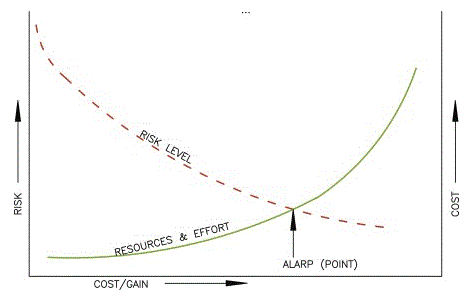Exploration Risk :
The ALARP principle is sometimes used in the oil and gas industry . The use of the ALARP principle may be interpreted as, satisfying a requirement to keep the risk level “as low as possible” provided that the ALARP evaluations are extensively documented. In the ALARP region (between “lower tolerable limit” and “upper tolerable limit”), the risk is tolerable, only if risk reduction is impracticable or if its cost is grossly disproportionate to the improvement gained. The common way to determine what is practicable is to use cost–benefit evaluations as a basis for the decision on whether certain risk reducing measures should be implemented. A risk may not be justified in any ordinary circumstance, if it is higher than the “upper tolerable limit.” The “upper tolerable limit” is usually defined, whereas the “lower tolerable limit” may sometimes be left undefined. This will not prohibit effective use of the approach, as it implies that ALARP evaluations of risk reducing measures will always be required. The ALARP principle used for risk acceptance is applicable to risks regarding personnel, the environment, and assets.
Layers of Protection Analysis (LOPA)
Percentil P10, P50, Pmean, P90 :
One technique that the industry uses to understand and quantify distributions of data is percentiles (or cumulative probabilities). This organizes the distribution into increments between 0 and 100. For example, the 10th percentile or P10 number say 10 percent of my wells will have a value “less than or equal to” my P10 value. The location of percentiles on a typical lognormal distribution would look something like:
Comparing to the P10, which could potentially give estimates that are over-optimistic, and the P90, a conservative estimate which could potentially leave too much oil, both providing confusing future trends. It is a common misunderstanding that the P50 is a synonym of P mean. This will be true is the probability distribution function for the observations were symmetrical. In this case, the mode, P mean and P50 would all be the same.
· N = OOIP (STB)
· 7758 = conversion factor from acre-ft to bbl
· A = area of reservoir (acres) from map data
· h = height or thickness of pay zone (ft) from log and/or core data
· ø = porosity (decimal) from log and/or core data
· Sw = connate water saturation (decimal) from log and/or core data
· Boi = formation volume factor for oil at initial conditions (reservoir bbl/STB) from lab data
· G = OGIP(SCF)
· 43560 = conversion factor from acre-ft to ft3
· Bgi = formation volume factor for gas at initial conditions (reservoir ft3/SCF)
· Solution gas : 18 – 25%
· Expansion : 2 – 5%
· Gas cap drive : 20 – 40%
· Water Drive (bottom) : 20 – 40%
· Water Drive (Edge) : 35 – 60%
· Gravity : 50 – 70%
Recovery Oil reserve = OOIP or OGIP x RF
"D" represents the value of the cash flows for each of the exercises, "i" the interest rate expected to be obtained or the rate of return of an investment of risk and similar duration and "n" the number of periods that it is estimated of the operation of the company.
Cash Outflows (expenditure)
- Initial investment to purchase assets
- Operating costs such as labor and materials
- Tax payments
- Project management expenses
- Any other outflow caused by accepting the project
Cash Inflows (income)
- Project revenues and grants
- Eventual scrap value of assets
- Any other inflow caused by accepting the project













No comments:
Post a Comment